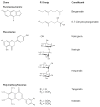Prioritizing pharmacokinetic drug interaction precipitants in natural products: application to OATP inhibitors in grapefruit juice
- PMID: 28032362
- PMCID: PMC5397323
- DOI: 10.1002/bdd.2061
Prioritizing pharmacokinetic drug interaction precipitants in natural products: application to OATP inhibitors in grapefruit juice
Abstract
Natural products, including botanical dietary supplements and exotic drinks, represent an ever-increasing share of the health-care market. The parallel ever-increasing popularity of self-medicating with natural products increases the likelihood of co-consumption with conventional drugs, raising concerns for unwanted natural product-drug interactions. Assessing the drug interaction liability of natural products is challenging due to the complex and variable chemical composition inherent to these products, necessitating a streamlined preclinical testing approach to prioritize precipitant individual constituents for further investigation. Such an approach was evaluated in the current work to prioritize constituents in the model natural product, grapefruit juice, as inhibitors of intestinal organic anion-transporting peptide (OATP)-mediated uptake. Using OATP2B1-expressing MDCKII cells (Madin-Darby canine kidney type II) and the probe substrate estrone 3-sulfate, IC50s were determined for constituents representative of the flavanone (naringin, naringenin, hesperidin), furanocoumarin (bergamottin, 6',7'-dihydroxybergamottin) and polymethoxyflavone (nobiletin and tangeretin) classes contained in grapefruit juice. Nobiletin was the most potent (IC50 , 3.7 μm); 6',7'-dihydroxybergamottin, naringin, naringenin and tangeretin were moderately potent (IC50 , 20-50 μm); and bergamottin and hesperidin were the least potent (IC50 , >300 μm) OATP2B1 inhibitors. Intestinal absorption simulations based on physiochemical properties were used to determine the ratios of unbound concentration to IC50 for each constituent within enterocytes and to prioritize in order of pre-defined cut-off values. This streamlined approach could be applied to other natural products that contain multiple precipitants of natural product-drug interactions. Copyright © 2016 John Wiley & Sons, Ltd.
Keywords: OATP2B1; drug interaction; grapefruit juice; simulation; transporter.
Copyright © 2016 John Wiley & Sons, Ltd.
Conflict of interest statement
The authors declare no conflicts of interest.
Figures



References
-
- Rodriguez-Fragoso L, Martinez-Arismendi JL, Orozco-Bustos D, Reyes-Esparza J, Torres E, Burchiel SW. Potential risks resulting from fruit/vegetable-drug interactions: effects on drug-metabolizing enzymes and drug transporters. J Food Sci. 2011;76:R112–24. doi: 10.1111/j.1750-3841.2011.02155.x. - DOI - PubMed
MeSH terms
Substances
Grants and funding
LinkOut - more resources
Full Text Sources
Other Literature Sources

